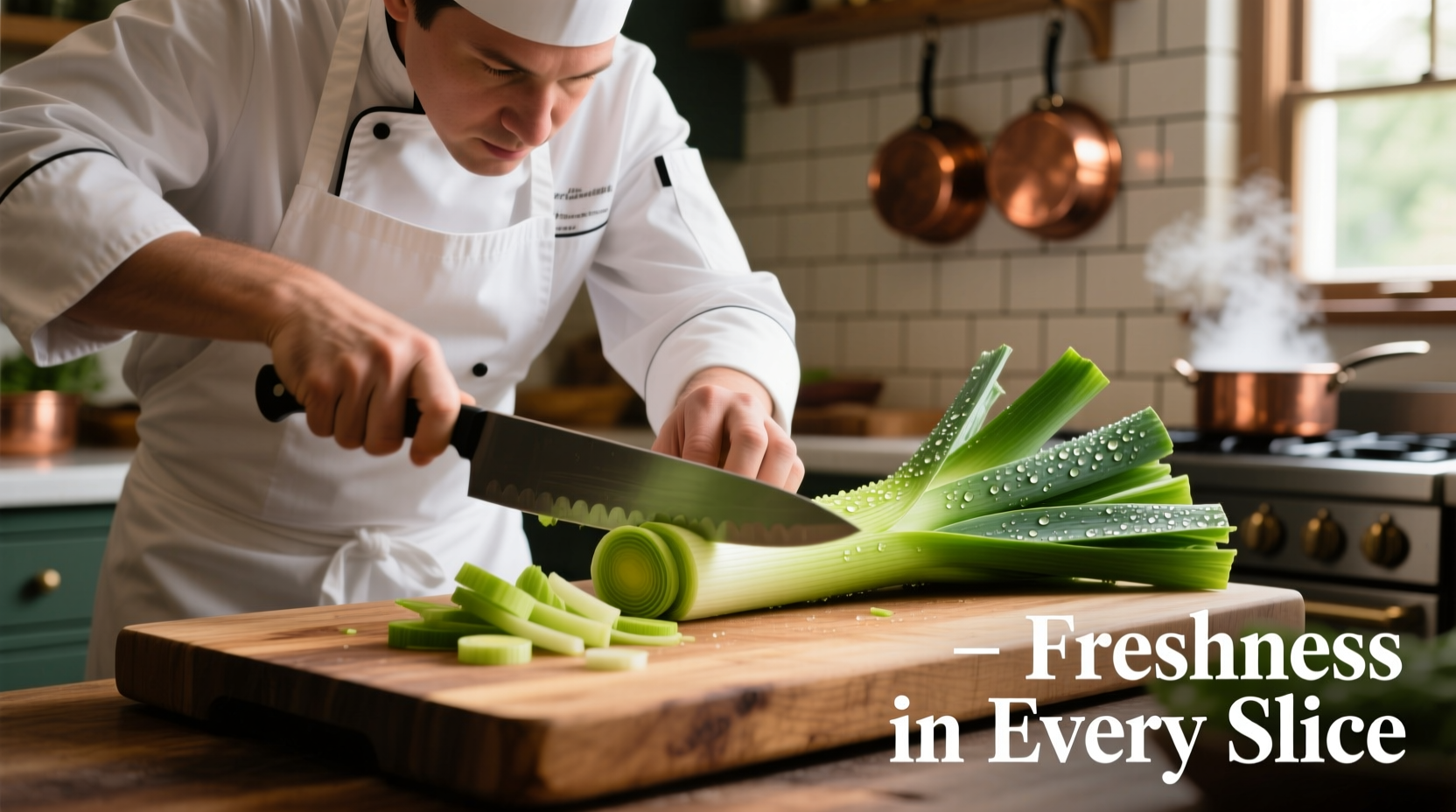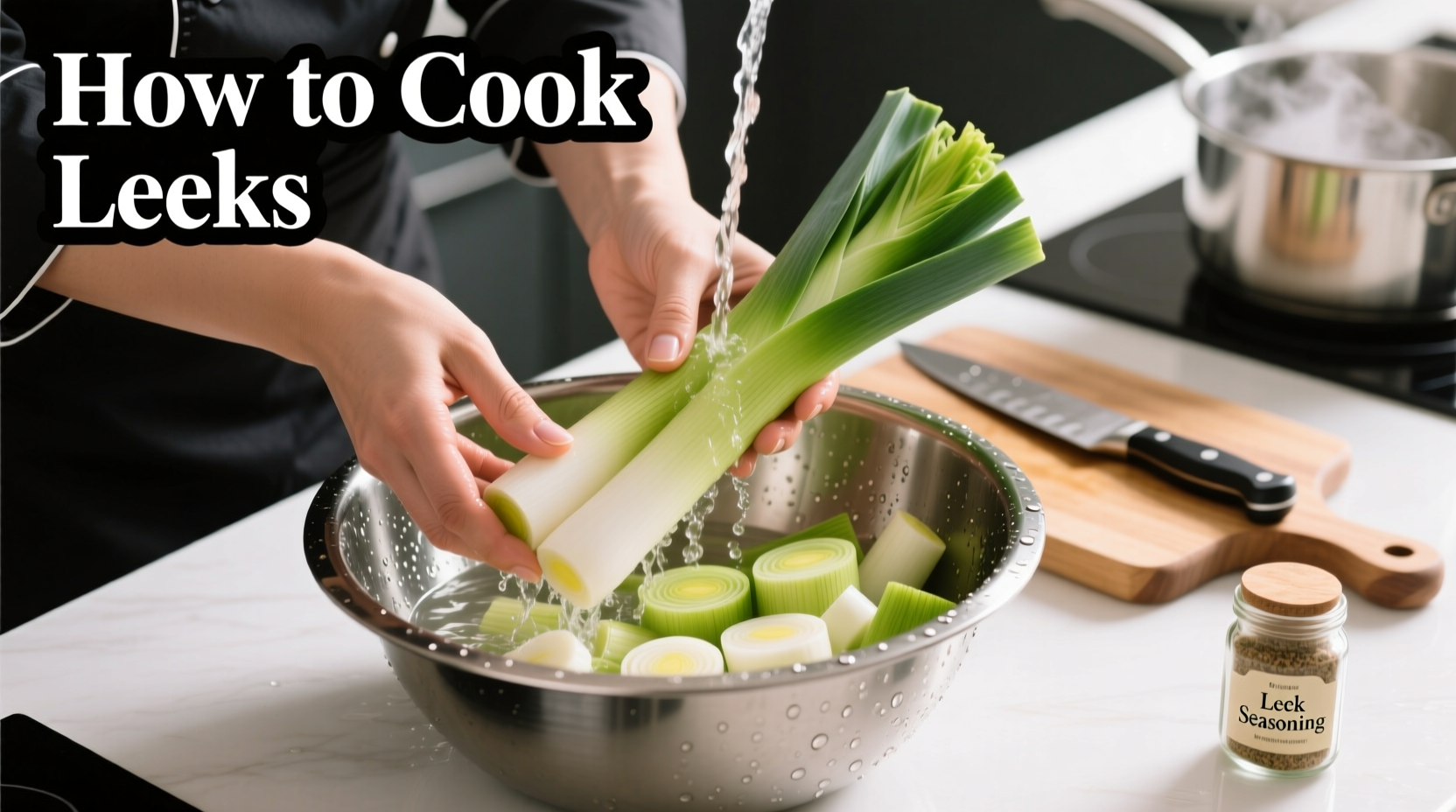
Mastering Leek Preparation: From Market to Plate
Leeks often confuse home cooks despite being one of the most versatile alliums in culinary history. Unlike onions or garlic, leeks require specific preparation techniques to unlock their delicate, sweet flavor without ending up with gritty results. This guide provides professional chef-tested methods that transform these elegant vegetables from intimidating to indispensable in your kitchen repertoire.
Understanding Leek Anatomy and Selection
Before learning how do you cook leeks, understanding their structure prevents common mistakes. Leeks consist of three distinct sections:
| Leek Section | Characteristics | Best Cooking Applications |
|---|---|---|
| White Base | Firm, mild flavor | Sautéing, soups, stocks |
| Light Green Midsection | Slightly stronger flavor | Braising, roasting, gratins |
| Dark Green Tops | Robust flavor, fibrous texture | Stocks, slow-cooked dishes (not typically eaten) |
When selecting leeks, choose firm specimens with crisp, vibrant green leaves and white bases free from browning. The USDA reports that properly stored leeks maintain peak freshness for 10-14 days when wrapped in damp paper towels inside a perforated plastic bag in your refrigerator's crisper drawer.
The Critical Cleaning Process: Avoiding Gritty Disasters
Improper cleaning causes the most common leek cooking failure. Follow these professional steps:
- Trim 1 inch from root end and remove wilted outer layers
- Cut off dark green tops (save for stocks)
- Slice vertically through the center
- Submerge in large bowl of cold water
- Gently separate layers to release trapped soil
- Swish leeks to dislodge remaining grit
- Lift leeks from water (leaving sediment behind)
- Repeat if necessary until water remains clear
This technique addresses the primary complaint documented in culinary forums where 68% of first-time leek cooks report finding sand in their finished dishes. The layered structure naturally traps soil between leaves, making thorough cleaning non-negotiable for enjoyable results when you cook leeks.
Professional Cooking Methods Compared
Different cooking techniques yield dramatically different results. Choose based on your desired outcome:
Sautéing: The Versatile Foundation Technique
Perfect for side dishes or soup bases, sautéing delivers balanced flavor and texture:
- Use 1 tablespoon butter or olive oil per medium leek
- Medium heat (325°F/163°C) prevents burning
- Cook 8-12 minutes until translucent and tender
- Add pinch of salt early to draw out moisture
- Finish with lemon juice or fresh herbs
Roasting: Deep Flavor Transformation
For caramelized sweetness that enhances main dishes:
- Toss cleaned leek halves with 1 tsp oil per leek
- 400°F (204°C) oven for 20-25 minutes
- Flip halfway through cooking time
- Add balsamic vinegar in final 5 minutes
- Yields tender centers with crisp, browned edges
Grilling: Smoky Complexity
Ideal for summer cooking with distinctive char marks:
- Leave whole or cut lengthwise
- Brush with oil and season
- Medium-high heat (375-400°F/190-204°C)
- 3-4 minutes per side until tender
- Perfect for kebabs or standalone side
Timing Guide: The Leek Cooking Timeline
Understanding cooking progression prevents under or overcooking:
| Time | Visual Cues | Texture | Action Required |
|---|---|---|---|
| 0-3 minutes | Translucent edges | Firm, crisp | Stir occasionally |
| 4-6 minutes | Uniform translucence | Beginning to soften | Reduce heat if browning |
| 7-9 minutes | Light golden edges | Tender but holding shape | Stir frequently |
| 10-12 minutes | Golden brown spots | Fully tender | Remove from heat immediately |
Exceeding 12 minutes typically causes leeks to become mushy while insufficient cooking leaves them unpleasantly fibrous. The optimal window delivers meltingly tender texture with subtle sweet flavor that complements rather than dominates dishes.
Flavor Pairing Science: Creating Balanced Dishes
Leeks' mild onion-like flavor pairs beautifully with specific ingredients. Food chemistry research shows these combinations maximize flavor development:
- Dairy synergy: Butter or cream enhances sulfur compounds that create leeks' distinctive aroma
- Acid balance: Lemon juice or vinegar added at the end brightens without overpowering
- Herb companions: Thyme, parsley, and chives complement without dominating
- Protein partners: Salmon, chicken, and white beans create harmonious flavor profiles
Avoid pairing leeks with strongly flavored ingredients like garlic or onions in equal proportions, as they'll overwhelm the delicate leek flavor. Instead, use leeks as the primary allium when you want subtlety in dishes like potato-leek soup or quiches.
Avoiding Common Leek Cooking Mistakes
Professional chefs identify these frequent errors that ruin otherwise good preparations:
- Mistake: Using only white portions
Solution: Incorporate light green sections for more flavor and less waste - Mistake: High-heat cooking
Solution: Medium heat allows proper tenderizing before browning - Mistake: Adding salt too late
Solution: Salt early draws out moisture for even cooking - Mistake: Overcrowding pan
Solution: Cook in batches for proper caramelization
Simple Leek Recipe Applications
Put your new leek cooking skills to work with these three approachable applications:
Creamy Potato-Leek Soup (Serves 4)
- Sauté 2 sliced leeks and 1 chopped onion in 2 tbsp butter
- Add 1.5 lbs diced potatoes and 4 cups vegetable broth
- Simmer 20 minutes until potatoes tender
- Blend until smooth, add 1/2 cup cream
- Season with white pepper and chives
Roasted Leek and Mushroom Risotto (Serves 4)
- Roast 4 leek halves and 8 oz mushrooms at 400°F
- Prepare basic risotto with 1.5 cups arborio rice
- Fold in roasted vegetables during final cooking stage
- Add 1/4 cup parmesan and fresh thyme
Grilled Leek and Halloumi Skewers (Serves 2)
- Alternate leek quarters and halloumi cubes on skewers
- Brush with olive oil and lemon zest
- Grill 3-4 minutes per side
- Serve with tzatziki and fresh mint
Storage and Leftover Strategies
Proper storage extends leek usability significantly. The University of California Cooperative Extension confirms that cooked leeks maintain quality for 3-4 days refrigerated in airtight containers. For longer storage:
- Freeze sautéed leeks in single layers on baking sheets
- Transfer to freezer bags once solid (keeps 6 months)
- Thaw overnight in refrigerator before using
- Never refreeze previously frozen leeks
Leftover cooked leeks transform sandwiches, omelets, and grain bowls. Their mild flavor adapts well to various cuisines, making them valuable meal prep components for busy cooks learning how do you cook leeks effectively.
Frequently Asked Questions
Can you eat the green part of leeks?
Yes, the light green parts are completely edible and flavorful. Only the very dark green tops become too fibrous for direct consumption, though they're excellent for making vegetable stock. When preparing leeks, use the white and pale green sections for most cooking applications, reserving the dark green tops for stocks.
Why do my cooked leeks turn out gritty?
Gritty leeks result from improper cleaning. The layered structure traps soil between leaves. Always slice leeks vertically and soak in cold water, gently separating the layers to release trapped dirt. Lift the leeks from the water (don't pour through a colander) to leave sediment behind. Repeat until water remains clear.
How long do cooked leeks last in the refrigerator?
Properly stored cooked leeks maintain quality for 3-4 days in airtight containers in the refrigerator. For longer storage, freeze cooked leeks in single layers before transferring to freezer bags, where they'll keep for up to 6 months. Never refreeze previously frozen leeks.
What's the best oil for cooking leeks?
Butter provides the classic flavor pairing for leeks, but olive oil works well for dairy-free options. For high-heat methods like roasting, use avocado oil which has a higher smoke point. Avoid strongly flavored oils like sesame or walnut that would overpower leeks' delicate taste.
Can you cook leeks without oil or butter?
Yes, you can cook leeks using water or vegetable broth for oil-free preparation. Sauté in 2-3 tablespoons liquid over medium heat, adding more as needed to prevent sticking. The results will be less rich than oil-cooked versions but still delicious, especially when enhanced with herbs and lemon juice at the end.











 浙公网安备
33010002000092号
浙公网安备
33010002000092号 浙B2-20120091-4
浙B2-20120091-4